Read about some of the details to consider when balancing rolls for high-speed chassis dynamometer testing.
“Highlights of 3D FEA modeling analysis”
Dyno Tech Talk is a compilation of copyrighted material, however, web sites are welcome to link to our Dyno Tech Talk index page.
What goes into roll balancing? It is more than just counterweighing the heavy side of the roll. The picture (at left) shows a DYNOmite roll on one of DYNOmite Dyno’s multi-plane dynamic balancing machines. The table below explains the necessity of doing dynamic multi-plane correction for high speed chassis dynamometer rolls. It also illustrates the futility of balancing a roll without addressing the effects that high-speed centrifugal deformation will have on the location of mass centers.
Try this link and its list of references for even more on balancing topics.
| Sectioned typical chassis dyno roll, with callouts for areas of balancing concerns. | 3D FEA simulation of spinning-roll deflection. Top image is at 60-MPH, bottom at 120-MPH. Note: model displacements exaggerated to aid visual analysis. | |
 Hover mouse over image (above) to toggle highlighting.Above image shows (expected) minor irregularities (exaggerated to aid viewing) of a typical chassis dyno roll assembly. These include:Roll shell imbalances (shown as internal bumps) due to mill forming tolerances, welding imperfections, surface scaling, handling damage, and machining tolerances.Radial run out, however slight, due to machining fixturing tolerances.Shaft deflection, even if ground shafting is used, occurs due to construction stresses. Even a few thousands of deflection can be an issue – as we explain towards the end of this table. | Hover mouse over images (at left) to show roll at rest.Baseline “Spin” images show roll with shell imperfections (e.g. far-left image) and construction run out, along with some shaft deflection – all creating imbalances. When spun, resulting dynamic forces cause serious stress and vibration.At high speeds, uneven (end-to-end) variations in mass result in a violent rocking coupling (lower image). This can eventually fail bearings, roll and frame welds, or even axle-shafts!Actual shell deflection, represented by “red” zones, is only about 0.001 inch. However, for a roll weighing over 1,000 pounds, that deformation represents hundreds of gram-inch imbalance.Note: upper (low-speed) analysis image is at 60 MPH (97 km/h) surface speed, vs. lower (high-speed) analysis image – at 120 MPH (193 km/h). | |
 Above image shows simple “static balancing,” via application of counterweights, at ends of roll assembly. Static balancing is done with roll on precision low-friction bearings, allowing gravity to find “heavy side.” Correction weights attach to end plates, opposite heavy zone, until roll balances.Static balance weights are ignorant of uneven end-to-end locations of inernal imbalance masses. Process is analogous to static (bubble) balancing automotive tires – and suffers from the same shortcomings at high speeds.Those two end imbalances get missed, because they cancel one another during this simplistic static balance. Since no RPM is applied during the static procedure, all dynamic imbalances are missed. Once this roll spins in service, its dynamically imbalanced ends will rock it violently! | Static Balancing is totally unsuitable for correcting imbalance in lengthy dyno rolls – used above very-low speeds. Notice the significant and uneven (rocking) deflections of the left vs. right axle-bearing stubs.At higher speeds end-to-end variations in balance create a violent rocking coupling that can eventually fail bearings or axle ends. The uneven and opposing directions of the end-to-end deflections are due to the inability of static balancing to provide correction for dynamic imbalances. In fact, static balancing often increases dynamic imbalance! | |
| External Dynamic Balancing is done by spinning the roll on a balancing machine. Unlike static balancing, the machine shows where to place weights that counter dynamic imbalances. These loads only show up as centrifugal force acts on the uneven end-to-end imbalanced masses. Note how both axle stubs deflect evenly and in the same direction – rocking forces are mostly gone.Unfortunately, at higher speeds, the roll’s shell deforms. Thus, some of the counterweighting correction, that was right for lower-speed cases, is now inappropriate for the roll’s new (again imbalanced) shape. | ||
| Internal (multi-plane) Dynamic Balancing is also done by spinning the roll on a balancer. However, counter weights go opposite actual imbalance areas. Notice, even at moderate speeds, counterweight areas exhibit a (desirable) mirrored “counter deformation.”Now look at the roll’s high speed shape. The counter-deformation symmetry keeps the roll shell in balance.Unfortunately, the shaft is still an issue. Its tiny (at-rest) bow becomes a major deflection – under high-speed centrifugal forces. This varying mass shift makes it impossible for the roll to stay in balance over a wide range of speeds. If dynamically balanced (to G1 specifications) at 1,000 RPM, it will be out of balance at any other speed. Forces increase exponentially with speed. If it vibrates at 1,500 RPM, at 3,000 it’s jumping off the ground! | ||
| Trued Shaft plus Multi-Plane Dynamic Balancing finally hits all the issues. Notice the axle stubs no longer deflect. In both low-speed and high-speed analysis images, sources of imbalance, and their respective contribution to uneven deformation, are now offset by “mirrored” counterweighting.Our roll runs smooth throughout its working range. This is the optimum way to balance any chassis-dyno roll assembly. |
